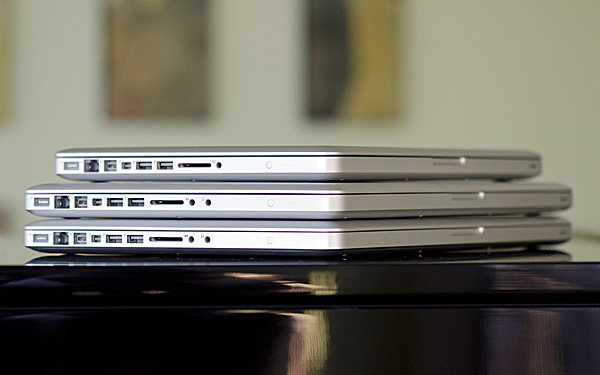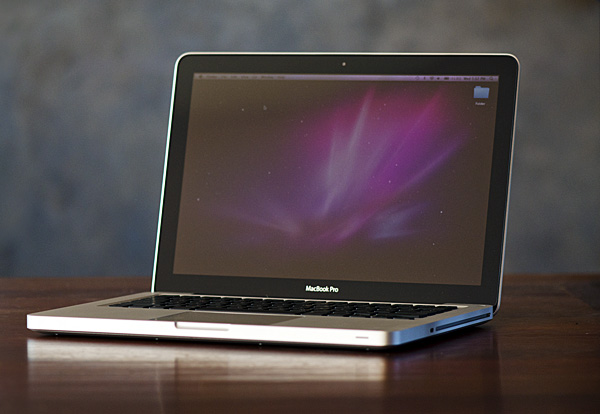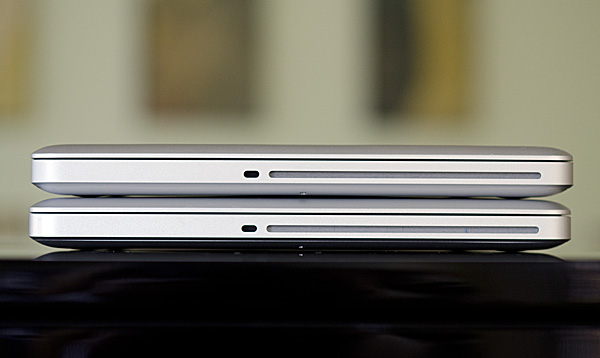The MacBook Pro Review (13 & 15-inch): 2011 Brings Sandy Bridge
by Anand Lal Shimpi, Brian Klug & Vivek Gowri on March 10, 2011 4:17 PM EST- Posted in
- Laptops
- Mac
- Apple
- Intel
- MacBook Pro
- Sandy Bridge
Last year at the iPad introduction Steve Jobs announced that Apple is a mobile device company. Just last week Steve returned to introduce the iPad 2 and point out that the majority of Apple's revenue now comes from products that run iOS. The breakdown is as follows:
| AAPL Revenue Sources—Q1 2011 | |||||||||
| iPad | iPhone | iPod | Mac | iTunes Store | Software/Services | Peripherals | |||
| Percentage | 17.2% | 39.1% | 12.8% | 20.3% | 5.4% | 2.9% | 2.2% | ||
Just looking at iPad and iPhone, that's 56% of Apple's sales. All Macs put together? Only 20%. Granted 20% of $26.7 billion in sales is still $5.3 billion, but the iOS crew gets most of the attention these days.
It shouldn't come as a surprise that when Apple launched its 2011 MacBook Pro lineup last week that it did so with little fanfare. There was no special press event and no video of an unusually charismatic man on a white background describing the latest features of the systems. All we got two weeks ago were a few pages describing the high level features of the lineup, a short outage on the Mac Store and five new configurations available for sale.

Apple tends to not mix architecture updates and chassis changes. The 2011 MacBook Pro lineup is no different. These models fundamentally implement the same updated unibody shell that was introduced in 2009. The term unibody comes from the fact that the base of the chassis is machined out of a single block of aluminum. There's no way to gain access to the MacBook Pro's internals from above, you have to go in from below. As a result there's absolutely no chassis flex or squeaking while you pound on the keyboard, use the trackpad or just interact with the part of the machine that you're most likely to be touching. Apple has been shipping unibody MacBook Pros since 2008 and from my experience the design has held up pretty well.

From top to bottom: 13-inch MBP (2011), 15-inch MBP (2011), 15-inch MBP (2010)
The biggest letdown in the design has been the hinge connecting the display to the rest of the chassis. I haven't had it fail completely but I've had it become frustratingly loose. Even brand new, out of the box, the 15-inch MacBook Pro will have its display move by a not insignificant amount if you tilt the machine 90 degrees so that the display is parallel to the ground. A number of readers have written me over the years asking if Apple has improved the locking ability of the hinge in each new version of the MacBook Pro. It doesn't seem to be any better with the 2011 model—sorry guys.
Other than screen size, ports and internals, there's nothing that separates the 13-, 15- and 17-inch MacBook Pros from one another. They all feature the same excellent backlit keyboard (keyboard size is constant across all models) and a variant of the same high quality display. All of them have the same front facing 720p camera and the same large glass-covered trackpad.
Battery capacity hasn't changed compared to last year, although power consumption on some models has gone up (more on this later).
| 2011 MacBook Pro Lineup | |||||||
| 13-inch (low end) | 13-inch (high end) | 15-inch (low end) | 15-inch (high end) | 17-inch | |||
| Dimensions |
0.95 H x 12.78 W x 8.94 D
|
0.95 H x 14.35 W x 9.82 D
|
0.98 H x 15.47 W x 10.51 D
|
||||
| Weight |
4.5 lbs (2.04 kg)
|
5.6 lbs (2.54 kg)
|
6.6 lbs (2.99 kg)
|
||||
| CPU |
2.3 GHz dual-core Core i5
|
2.7 GHz dual-core Core i7
|
2.0 GHz quad-core Core i7
|
2.2 GHz quad-core Core i7
|
2.2 GHz quad-core Core i7
|
||
| GPU |
Intel HD 3000 Graphics
|
Intel HD 3000 + AMD Radeon HD 6490M (256MB)
|
Intel HD 3000 + AMD Radeon HD 6750M (1GB)
|
Intel HD 3000 + AMD Radeon HD 6750M (1GB)
|
|||
| RAM |
4GB 1333MHz DDR3 (8GB max)
|
||||||
| HDD |
320GB 5400 RPM
|
500GB 5400 RPM
|
500GB 5400 RPM
|
750GB 5400 RPM
|
750GB 5400 RPM
|
||
| Display Resolution |
1280x800
|
1440x900 (1680x1050 optional)
|
1920x1200
|
||||
| Ports |
Gigabit LAN, Firewire 800, Thunderbolt, 2x USB 2.0, SDHC slot, combined audio in/out jack
|
Gigabit LAN, Firewire 800, Thunderbolt, 2x USB 2.0, SDHC slot, separate audio in/out jacks
|
Gigabit LAN, Firewire 800, Thunderbolt, 3x USB 2.0, separate audio in/out jacks, ExpressCard 34 slot
|
||||
| Battery Capacity |
63.5Wh
|
77.5Wh
|
95Wh
|
||||
| Price | $1,199 | $1,499 | $1,799 | $2,199 | $2,499 | ||
The new MacBook Pros are still equipped with DVD drives and thus Apple still distributes OS X and the application preload on a pair of DVDs. I was hoping Apple would go to an all-USB distribution starting with the MBA but it looks like we'll have to wait for another generation of Pro systems before we see that.












198 Comments
View All Comments
ImSpartacus - Thursday, March 10, 2011 - link
Apple doesn't do something unless they can do it 100%.They won't default to SSDs until they are on the logic board like the MBA. We'll probably see the disk drive go at the same time.
Maybe Apple will continue to use hard drives for storage? That might be the reason we are still seeing 5400rpm drives. Apple doesn't want to upgrade everyone to 7200rpm drives only to have 5400rpm drives the next year, even only for storage.
But who knows?
Tros - Thursday, March 10, 2011 - link
I imagine they'd go for the MBA-SSD and the larger platter-based storage, and just partition. But to do that smoothly, they need a better partitioning system (to keep it user friendly); ZFS.Nentor - Friday, March 11, 2011 - link
Apple doesn't do something unless they can do it grand (or make it seem grand).Why put in SSD standard if they are still a luxury? As long as the average pc user is not fully aware of what SSD are and what are the great benefits you can still demand premium for them as an upgrade for people that do want one.
Just watch, when SSD are becoming the standard Apple will put put them in and market the hell out of it and make it fit the whole Apple image.
dsumanik - Friday, March 11, 2011 - link
Dude, if your hdd is integrated into your mobo... Not only do have the disadvantage of not being able to upgrade to faster/larger capacity drives...If the disk fails you need to replace the whole board - $$$
If something on the board fails, you lose all your data - facepalm
Apple dictates the price of of the hdd, even when it's a yer old - $$$
A simple, 2 screw user replaceable hdd is the elegant solution and always will be.
Wake up peeps...
They aren't supporting other drives because they want to sell you outdated technology at a higher price.... End of story.
JasperJanssen - Monday, March 14, 2011 - link
Dude, do you even have a vague clue what you are talking about?The MBA doesn't have an SSD soldered onto the mainboard, it has it on a standardised daughter card. And by standardised I don't mean standardised by Apple, although to be fair Apple is the main supplier of machines using it at the moment. It's a card not unlike minipci(e), and entirely swappable from one machine to a replacement. Also, Apple isn't the only one supplying these drives.
It's entirely possible that other thing&light manufacturers will start using them, as it's a very useful form factor.
KoolAidMan1 - Thursday, March 10, 2011 - link
There is no dedicated GPU in the 13" MBP because there isn't room for it. Look at other notebooks in the same size and price class such as the Lenovo x220. Same situation, integrated GPU only. An dedicated GPU means bigger motherboard, which defeats the purpose of notebooks that are so small.Wieland - Thursday, March 10, 2011 - link
Sandy Bridge laptops haven't been on the market very long. It's way too early to make a conclusion about what is and isn't possible in terms of size. That said, the Sony Vaio S is basically the exact same size, lower weight, lower price, and offers almost as much battery life, and it is configurable with two different versions of AMD Radeon Graphics (6470M, 6630M). The new Vaio Z will probably be even more impressive in this regard.ltcommanderdata - Thursday, March 10, 2011 - link
The 13" MacBook Pro is a constant 0.95" thickness. The Vaio S ranges from 1.08" - 1.24" thick, a 14% to 31% difference. So the 13" MacBook Pro has significantly decreased internal volume which will definitely constrain how you lay out internal components and the thermal room on the machine impacting whether it's worthwhile to put in a discrete GPU.claytontullos - Thursday, March 10, 2011 - link
Have you dealt with HP's tech support? It's like pulling teeth to get anything done.My ram in my Dv4 was bad, it would randomly cause windows to crash both in Vista and Windows 7. My ram failed memtest86 with over 4 million errors after a few minutes of testing... however my ram would pass HP's 5 second ram test with flying colors.
HP's support first insisted I revert my laptop back to Vista and in any event would not service my laptop because the ram passed their "test."
I will never buy another HP product.
quiksilvr - Thursday, March 10, 2011 - link
I won't judge a race based on the actions of few. At the same time, I won't judge a company just because one of their products didn't work that well for me. That's like saying I bought a 4 pack of Duracells and one of the batteries weren't working so now I buy Energizer.And to be fair, it isn't like HP made the RAM. If you were getting random crashes, you obviously didn't do anything and are clearly under warranty. Simply say "I turned it on and it keeps crashing" and they'll say "Okay here send it back" and 9/10 they will pay for shipping (depending on where you got it from).
Now I'm not an HP fanboy (far from it, I own a Lenovo), but prior to that I owned a zd8000 for about 5 years with no problems. Does that mean that HP is utterly flawless and no one makes a product like them? No. But I know quality when I see one and I stand by what I said: The Envy 14 is probably one of the best laptops you can get. Hell, it's only $999 and it blows the MBP out of the park.